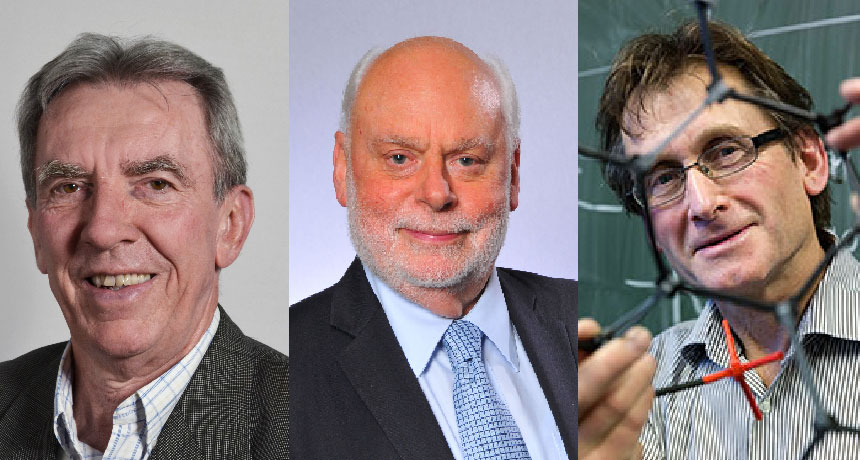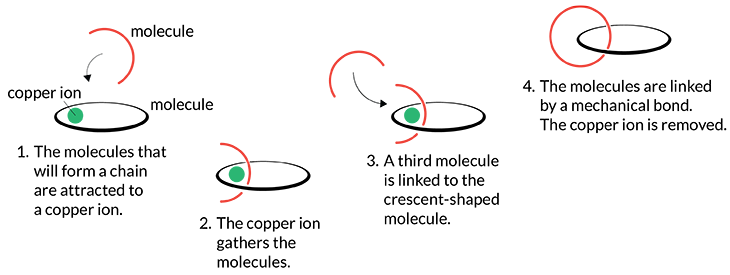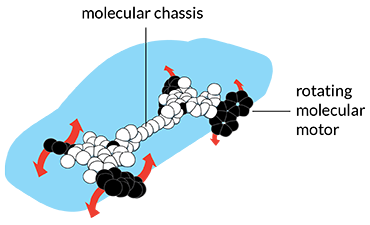
LIVING LARGE Jean-Pierre Sauvage, J. Fraser Stoddart, and Bernard Feringa won the 2016 Nobel Prize in chemistry for constructing teeny-tiny molecular machines.
L-R: ISIS, Northwestern University, University of Groningen
Motors too small to see with the eye may soon have the power to drive innovations in chemistry, biology and computing. Three creators of such nanoscopic machines were honored October 5 with the Nobel Prize in chemistry.
Sharing the prize of 8 million Swedish kronor (about $930,000) equally are Jean-Pierre Sauvage, J. Fraser Stoddart and Bernard Feringa. “If you had to choose three people at the top of the field, that’s it. These are the men,” says James Tour, a nanomachines chemist at Rice University in Houston. ”It is a well-warranted prize.”
Recognition of the burgeoning field of molecular motors will draw more money and inspire children to become scientists, says Donna Nelson, an organic chemist at the University of Oklahoma in Norman and the president of the American Chemical Society. “It will benefit not only these three chemists, it will benefit the entire field of chemistry.”
Chemists and physicists have envisioned molecular machines since at least the 1960s, but were never able to reliably produce complex structures. Then in 1983, Sauvage, of the University of Strasbourg in France, devised a method for making interlocking molecular rings, or catenanes. Sauvage’s molecular chain set the stage for the rest of the field (SN: 9/8/90, p. 149).
Stoddart, of Northwestern University in Evanston, Ill., improved the efficiency so that he could produce large quantities of molecular machines, starting in 1991 with rings clipped around a central axle. That structure is known as a rotaxane. He and colleagues learned to control the slide of the rings along the axle, making a simple molecular switch. Such switches could be used to create molecular computers or drug delivery systems. Stoddart showed in 2000 that it was possible to make molecular “muscles” using interlocking rings and axles. Stoddart and colleagues have since devised molecular elevators and pumps based on the same molecules.
Feringa, of the University of Groningen in the Netherlands, ramped things up another notch in 1999 by building the first molecular motor. Things move so differently at the molecular scale that many researchers weren’t sure anyone could precisely control the motion of molecular motors, says R. Dean Astumian of the University of Maine in Orono. Feringa’s innovation was to devise asymmetric molecules that would spin in one direction when hit with a pulse of light.
Up to 50,000 of the motors could span the width of a human hair, says Tour. Alone, one of the spinning motors doesn’t pack much punch (SN: 2/7/04, p. 94), but harnessed together in large numbers the little motors can do big work, he says. Groups of the whirring motors powered by light can rotate a glass rod thousands of times their size and do other work on a macroscopic scale. Feringa also harnessed his motors into a four-wheel-drive “nanocar” (SN: 12/17/11, p. 8).
The process of making molecular machines has improved drastically over recent decades, thanks in large part to the work of the three newly christened laureates, says Rigoberto Advincula, a chemist at Case Western Reserve University in Cleveland. Scientists have a better understanding of how to construct molecules that more reliably bend, loop and connect to form shapes. “You don’t have tweezers to put them together,” he says. “You template the reaction so that the thread to goes through the ring. That then makes it easier for the two thread ends to meet each other.” New techniques have also allowed the production of more intricate shapes. Further development will bring these processes to even bigger scales, allowing for the design of molecular machines for everything from energy harvesting to building protein complexes, Advincula says.
Such applications are still on the horizon and no one really knows what sorts of machines chemists can make from molecules yet. When people question Feringa about what his molecular motors can be used for, he “feels a bit like the Wright brothers” when people asked them after their first flight why they needed a flying machine, he said during a telephone call during the announcement of the prize. There are “endless opportunities,” including nanomachines that can seek and destroy tumor cells or deliver drugs to just the cells that need them, Feringa speculated.
Stoddart, who was born in Edinburgh and moved to the United States in 1997, applauded the Nobel committee for recognizing “a piece of chemistry that is extremely fundamental in its making and being.” Sauvage, in particular, created a new type of molecular bond in order to forge his chain, Stoddart said during a news conference. “New chemical compounds are probably several thousand a day worldwide,” he said. “New chemical reactions, well, maybe a dozen or two a month. Maybe I go over the top there. But new bonds, they are few and far between. They are really the blue moons. So I think that’s what’s being recognized, more than anything.”









